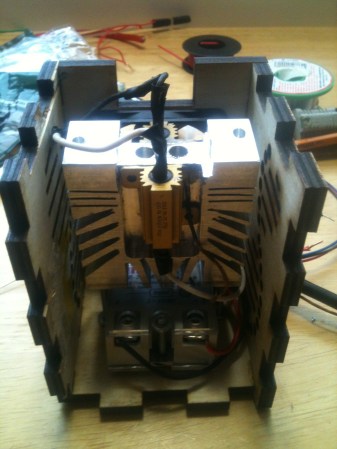One of our grad students just pointed me to the OpenPCR project at OpenPCR – the $599 Thermal Cycler / PCR Machine.

The machine is a thermal cycler that is controlled via a USB cable from a computer (PC or Mac, probably Linux as well, if you can figure out how to modify the code to talk to the USB port on your version of Linux). It comes as a kit that you assemble yourself (from laser-cut wooden parts, which are probably not very sturdy, but give a nice homebrew feel to the machine. You’d have to add some brass gears if you want a steampunk look.
Since commercial PCR machines are in the $3000 range, a $600 option seems like a good choice, even if you do have to tie up a computer to run the machine. (Almost every school or lab that would want a thermal cycler has computers sitting around, especially since an old slow computer is all you need for this application.)
From a quick look at the information on the Downloads site, it seems that the machine has an Arduino as the controller, with an H-bridge (to power a Peltier-junction heater/cooler) and a high-resolution analog-to-digital converter (to read the block temperature). The lid also has a heater and a temperature sensor, but no cooler. The lid heater is controlled by the Arduino with a simple MOS transistor, and the temperature sensor is read directly by the Arduino—high precision is not as important for the lid as for the block. There is a big heat sink and a fan for the back side of the Peltier junction—they take up most of the room in the box.
They provide detailed assembly instructions for download that have not been properly compressed—it’s a 109-Mbyte file that takes forever to download from their slow site, with pictures that seem designed for book-quality printing. It would have been nice for them to provide lower-resolution pictures in under 20Mbytes as an option, or even HTML instructions that could be viewed a page at a time without needing to download everything.
The machine holds 16 200-microliter tubes, but does not appear to come with any, nor with any reagents. There also do not seem to be any use instructions—once you’ve verified that the thermal cycler is working, you seem to be on your own for figuring out how to use it. I assume that the OpenPCR people expect the forum to handle questions like that (or they are hardware hackers who can’t be bothered to deal with messy wet protocols), but there are no useful messages on the forums yet. The best sources for PCR protocols seem to be from the vendors of the polymerase and other reagents. Googling “PCR protocol” finds several such sources.
I have no intention of getting a PCR machine myself (my eye-sight, hand-eye coordination, and patience with boring tasks are all too poor for me to do wet-lab work), but this looks like a good option for high school labs.
Tagged:
Arduino,
bio-hacking,
open-source hardware,
OpenPCR,
PCR,
thermal cycler 












